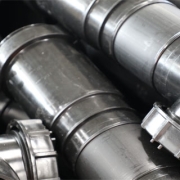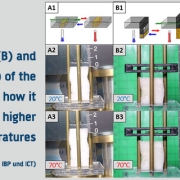Peel L&P say each individual home at Redbridge Quay is being “precision-engineered using Modern Methods of Construction (MMC) and will exceed all carbon reduction targets”. Town House alone is described as over 50% more energy efficient than the average new build home.
THE first residents have moved into homes on Wirral Waters’ now completed Redbridge Quay development.
 Arthur and Doreen initially left Liverpool and moved to Lancaster but say there were drawn back to the city region because of its history and connectivity.
Arthur and Doreen initially left Liverpool and moved to Lancaster but say there were drawn back to the city region because of its history and connectivity.
They really enjoy being by the water, so when they found Redbridge Quay, they sold up and moved straight back.
Located in the emerging Northbank neighbourhood at Wirral Waters, the waterside development is surrounded by beautiful Grade II listed grain warehouses, a new pocket park, green landscaping and new public realm, including dockside walkways.
Arthur and Doreen initially left Liverpool and moved to Lancaster but say there were drawn back to the city region because of its history and connectivity.
They really enjoy being by the water, so when they found Redbridge Quay, they sold up and moved straight back.
Located in the emerging Northbank neighbourhood at Wirral Waters, the waterside development is surrounded by beautiful Grade II listed grain warehouses, a new pocket park, green landscaping and new public realm, including dockside walkways.
Wirral estate agent, Jones & Chapman, has been appointed by Peel L&P to market and sell the highly sustainable two, three and four-bedroom, modular homes now complete at Redbridge Quay, Wirral Waters.
The estate agent will market over 350 homes which will make up this development, with the first phase of 30 homes now complete.
Peel L&P say each individual home at Redbridge Quay is being “precision-engineered using Modern Methods of Construction (MMC) and will exceed all carbon reduction targets”. Town House alone is described as over 50% more energy efficient than the average new build home.
Richard Mawdsley, Peel L&P’s director of development for Wirral Waters, said: “We are delighted to welcome Arthur and Doreen to Redbridge Quay and hope they will enjoy everything that Wirral Waters, and the Wirral, has to offer.
“We are also pleased to appoint Jones & Chapman as the agent for Redbridge Quay and look forward to welcoming them to the Wirral Waters family.
“This is a very exciting residential development for the Wirral as it will bring the very latest in sustainable housing design and innovation to the area which will be a huge appeal for so many families looking for a sustainable, energy efficient home.”
Claire Scott, land and new homes director for the North and Scotland, Sequence Homes, added: “Wirral Waters is one of the most exciting regeneration projects in the UK presently.
Source: Wirral Globe













